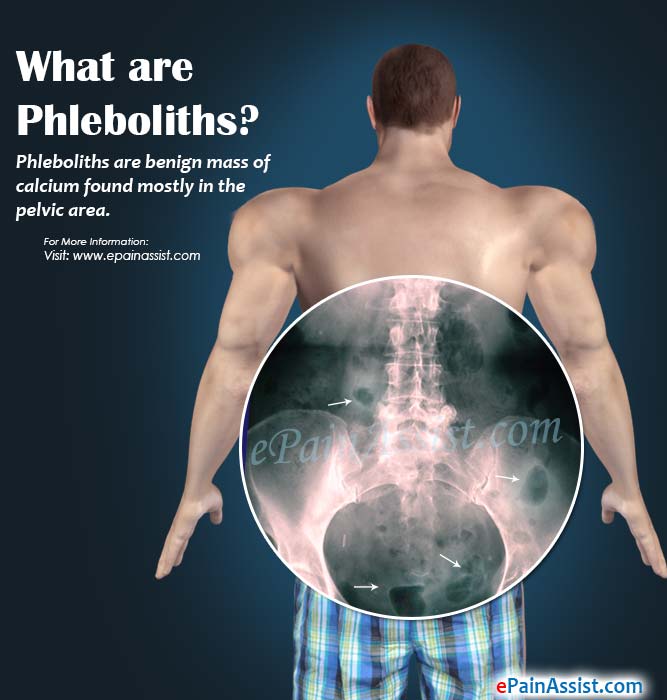What are Phleboliths?
Phleboliths are benign mass of calcium found mostly in the pelvic area. They are generally harmless and are of no cause for concern, although the presence of Phleboliths may indicate the presence of a more serious underlying problem that may need immediate medical attention.
Phleboliths is a condition which is quite difficult to diagnose as its symptoms resemble that of many other more common conditions and majority of the cases of Phleboliths are diagnosed when radiological studies are done for some other medical condition and Phleboliths are in incidental finding on the studies.
There are various causes for the development of Phleboliths which may range from pressure in the veins to straining during bowel movements. Liver dysfunction may also cause development of Phleboliths. Abdominal pain is one of the main presenting features of Phleboliths. Bladder discomfort is also one of the symptoms of Phleboliths. As majority of cases of Phleboliths are benign and harmless thus no treatment is required, although acute cases of Phleboliths where it causes significant discomfort to the patient may require treatments so as to ease the discomfort and treat Phleboliths.

What Causes Phleboliths?
Some of the common causes of Phleboliths are:
- Increased Pressure in Veins: Any injury in the veins caused as a result of increased pressure in the vein may result in development of Phleboliths.
- Varicose Veins: Varicose veins are the cause as well as a symptom of Phleboliths.
- Bowel Movements: Straining during bowel movements may cause increased blood pressure and result in development of phleboliths due to excessive pressure.
- Liver Dysfunction: Some types of liver dysfunction are also related to the development of Phleboliths.
What are the Symptoms of Phleboliths?
Some of the classic presenting features of Phleboliths are:
- The person suffering from Phleboliths will experience symptoms of pain in the abdominal and pelvic area. This pain may not be the intense pain seen with renal stones but usually is mild to moderate.
- Another symptom for Phleboliths is the presence of thrombosis. Thrombosis can cause blood flow to slow down and when this happens you may experience a variety of other symptoms related to thrombosis. If an individual is diagnosed with thrombosis then in most cases he or she may be having Phleboliths as well.
- The presence of Phleboliths also tends to cause the pelvic veins to dilate and cause a varicose vein like situation which might also cause pain in the pelvis
- Bladder Discomfort. Phleboliths also tends to cause discomfort in the bladder and kidneys.
How is Phleboliths Diagnosed?
As stated above, the diagnosis of Phleboliths are extremely difficult since the symptoms of this condition resemble that of many other medical conditions and most of the times Phleboliths are diagnosed on radiological studies as an incidental finding.
How are Phleboliths Treated?
Minor cases of Phleboliths do not require any treatment as it is a benign condition and certain home remedies which have been delineated below are good enough to treat Phleboliths.
The more acute cases of Phleboliths which may cause significant discomfort to the patient may require treatment. The treatments for Phleboliths vary and differ on a case to case basis.
Some of the Treatments Given for Severe Cases of Phleboliths are:
Sclerotherapy to Treat Phleboliths
This therapy is basically used for treating venous malformations by closing the veins. This type of therapy is not a permanent solution and may have to be repeated in the future in cases of recurrence as well.
Endovenous Laser Therapy
This is a relatively new method designed for treating varicose veins but is equally effective in treating Phleboliths as well. This is a minimally invasive procedure and the patient does not have to stay in the hospital for the procedure to be performed. It usually takes about an hour to do this procedure and treat Phleboliths.
Surgical Excision
Surgical excision of the Phleboliths can also be performed but this is usually done in extreme cases of Phleboliths and when all other approaches towards treatment have failed to give the desired results and alleviating the discomfort the patient is experiencing because of Phleboliths.
Home Remedies for Phleboliths
Minor cases of Phleboliths can be easily treated by utilizing the below mentioned home remedies, although it is recommended to consult with a physician before embarking on any of these remedies.
Wet Washcloth: You can soak a washcloth in warm water and apply it over the area of discomfort. This needs to be done several times a day to completely get relief from the symptoms of Phleboliths
Antiinflammatories: Antiinflammatories can also be utilized for relief of pain and inflammation caused by Phleboliths. They are normally prescribed by the treating physician and are required by the patient to take diligently for successful treatment of Phleboliths.
How to Prevent Phleboliths?
Phleboliths may be a benign condition but there are several ways to prevent this condition from arising in the first place. Some of the ways to prevent Phleboliths from occuring are:
- Avoid being sedentary for a long period of time even if it is just a bit of stretching of the hands and legs or a short walk so that blood flow is not slowed down which may result in varicose veins which is a known cause of Phleboliths.
- Avoid Tight Clothing: Try and avoid wearing tight clothing as tight clothing will prevent free flow of blood which may result in development of Phleboliths.
- Stay Hydrated: Drink plenty of fluids as dehydration can cause increased blood pressure and put more pressure on the walls of the vein which will ultimately result in the development of Phleboliths.
